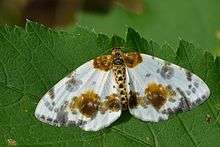Abraxas sylvata
| Abraxas sylvata | |
|---|---|
 | |
| Scientific classification | |
| Kingdom: | Animalia |
| Phylum: | Arthropoda |
| Class: | Insecta |
| Order: | Lepidoptera |
| Family: | Geometridae |
| Genus: | Abraxas |
| Species: | A. sylvata |
| Binomial name | |
| Abraxas sylvata | |
| Synonyms | |
| |
Abraxas sylvata, the clouded magpie, is a moth of the family Geometridae that was named by Giovanni Antonio Scopoli in 1763.
Description
This moth is mostly white with brownish patches across all of the wings. There are small areas of pale gray on the forewings and hindwings. They resemble bird droppings while resting on the upper surface of leaves.[1] The adults fly from late May to early August. They are attracted to light. The wingspan is 38 mm. to 48 mm.[1] The moth is nocturnal and is easy to find during the day.[2] They are easy to find resting during the morning.[3] The moth starts being active at early dusk.[4] The moths eat the plants Betula, Corylus, Fagus, Ulmus, Prunus, and Frangula.[5] Abraxas grossulariata is similar to this species.[3] In a group of specimens of this species, the largest one is 60 mm. while the smallest one is 31 mm. The moth is more common in Eastern Asia than in Europe.[6] The species is listed as a priority species in the United Kingdom Biodiversity Action Plan.[7]
Caterpillars
Caterpillars appear from mid-July to early October. They overwinter as a pupa. The body of the caterpillar is distinctive because it is marked with longitudinal black and yellow stripes.[8] The caterpillars feed on wych elm and common elm.[2] The pupa hibernates underground. The caterpillars live on several deciduous trees such as Fagus sylvatica, Ulmus glabra, and Ulmus procera.[4]
Habitat
The moth was considered rare until the late 1990s in Northern Ireland. The species can be found from Europe to Japan.[1] The moth can be found in forests, thickets, and sometimes parks on various deciduous trees.[9]
Subspecies
- Abraxas sylvata sylvata
- Abraxas sylvata microtate Wehrli, 1931 (Japan)[10]
Gallery
 Larva
Larva Pupa
Pupa Mounted
Mounted Illustration from John Curtis's British Entomology Volume 6
Illustration from John Curtis's British Entomology Volume 6
References
- 1 2 3 "Clouded Magpie". The Butterflies and Moths of Northern Ireland. Retrieved 2010-05-29.
- 1 2 "1885 Clouded Magpie (Abraxas sylvata) Han". Hantsmoths. Retrieved 2010-05-29.
- 1 2 "1885 Clouded Magpie Abraxas sylvata, (Scopoli, 1763)". Huntingdonshire Moth & Butterfly Group. Retrieved 2010-05-29.
- 1 2 "Abraxas sylvata (Scopoli, 1763)". Catalogue of the Lepidoptera of Belgium. Retrieved 2017-03-08.
- ↑ "Abraxas sylvata Clouded Magpie (Scopoli, 1763)". Lepidoptera.se. Retrieved 2010-05-29.
- ↑ Leech, John Henry (1897). "On Lepidoptera Heterocera from China, Japan, and Corea". The Annals and Magazine of Natural History: Including Zoology, Botany, and Geology. 6. Taylor & Francis. 19: 445 – via Google Books.
- ↑ "Moth species recorded in the East Midlands Region". Butterfly Conservation. Retrieved 2010-05-29.
- ↑ "1885 Clouded Magpie Abraxas sylvata (Scopoli, 1763)". UKMoths. Retrieved 2010-05-29.
- ↑ "Porcelain butterfly (Abraxas sylvata)". Vlindernet.nl. Retrieved 2010-05-29.
- ↑ Japanese Moths
External links
| Wikimedia Commons has media related to Abraxas sylvata. |
| Wikispecies has information related to Abraxas sylvata |